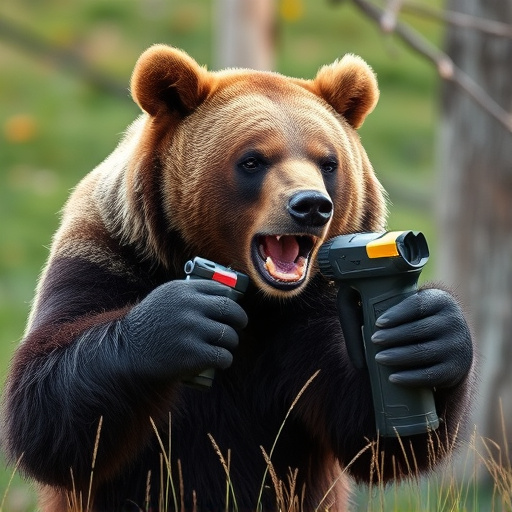Grizzly bears pose a safety concern in wilderness areas due to unpredictable behavior and strong charging instincts. Understanding bear charge patterns is vital for hikers, who should make noise while trekking as a preventive measure. Bear spray, an aerosol tool using capsicum from chili peppers, is popular but varies in legality; knowledge of local laws is crucial. While bear spray isn't a guarantee against aggression, other strategies like making noise, wearing reflective clothing, traveling in groups, and proper food storage can significantly enhance safety in bear country.
In the vast wilderness, encounters with grizzly bears can be intimidating. Understanding bear behavior and equipping yourself with effective defense mechanisms is crucial for safety. This article explores the unpredictable nature of grizzly charges and provides insights into practical strategies. We delve into the effectiveness of bear spray, its legal status as a defense weapon, and offer alternative tactics to enhance your wilderness survival skills. Learn how to navigate these powerful creatures’ habitats while minimizing risks.
- Understanding Grizzly Bear Behavior and Their Charging Patterns
- Exploring Bear Spray: Its Effectiveness and Legal Status as a Defense Weapon
- Beyond Bear Spray: Additional Strategies for Protecting Yourself in the Wilderness Against Charging Grizzlies
Understanding Grizzly Bear Behavior and Their Charging Patterns
Grizzly bears, known for their immense strength and unpredictable nature, can charge at speeds reaching up to 30 miles per hour. Understanding their behavior is crucial for safety in wilderness areas. These bears often charge when they feel threatened or surprised, with their primary goal being to protect themselves or their cubs. Knowing this pattern allows hikers and outdoor enthusiasts to take preventive measures, such as making noise while trekking to avoid startle reactions.
The concept of using bear spray as a defense mechanism has gained popularity, but it’s essential to understand its limitations. Bear spray is not a restricted weapon; rather, it’s a deterrent designed to create a barrier between the bear and the person. However, success depends on proper usage, including aiming for the bear’s face and ensuring adequate distance. Despite its effectiveness in many cases, bear spray doesn’t guarantee complete protection, especially during aggressive encounters.
Exploring Bear Spray: Its Effectiveness and Legal Status as a Defense Weapon
Bear spray, also known as pepper spray designed for wildlife encounters, has gained popularity as a defensive tool against grizzly bears. It’s an aerosol can containing capsicum, a compound derived from chili peppers, which irritates the bear’s eyes and respiratory system, temporarily disabling it. This allows individuals to escape potential attacks. However, its effectiveness varies based on factors like wind direction, spray range, and the bear’s size and aggression level.
In terms of legal status, bear spray is generally considered less restrictive than firearms or other lethal weapons. Many jurisdictions allow its use for defense against bears, especially in wilderness areas where encounters are common. However, regulations differ widely across regions, with some places restricting its sale, possession, or use without a permit. Understanding local laws regarding bear spray is crucial before venturing into bear country to ensure compliance and maximize safety during potential encounters.
Beyond Bear Spray: Additional Strategies for Protecting Yourself in the Wilderness Against Charging Grizzlies
In addition to bear spray—a popular yet potentially restricted weapon (depending on location) for deterring bears—there are several other strategies to consider when protecting yourself in the wilderness against charging grizzly bears. One key approach is to make noise, such as talking or singing loudly, to signal your presence and hopefully scare off any potential attackers before they get too close. Wearing bright, reflective clothing can also help bears spot you from a distance, reducing the likelihood of an unexpected encounter.
Another effective tactic is to travel in groups. Bears are typically wary of humans, but a group’s larger size and noise level can deter even aggressive bears. Additionally, carrying and knowing how to use a bear bell or gung-ho can be invaluable tools. These devices create noise that can alert bears to your presence, allowing you time to adjust your route or prepare for an encounter. Always stay aware of your surroundings, avoid known bear habitats during peak activity periods, and properly store food to minimize attracting wild bears.
In conclusion, understanding grizzly bear behavior and employing effective defense strategies is crucial for safety in the wilderness. While bear spray has proven effectiveness against charging bears, its legal status as a restricted weapon varies. Beyond bear spray, additional measures such as making noise to deter bears and knowing where to seek shelter can significantly enhance your protection. By combining these methods, you can navigate encounters with grizzly bears more confidently and safely.
